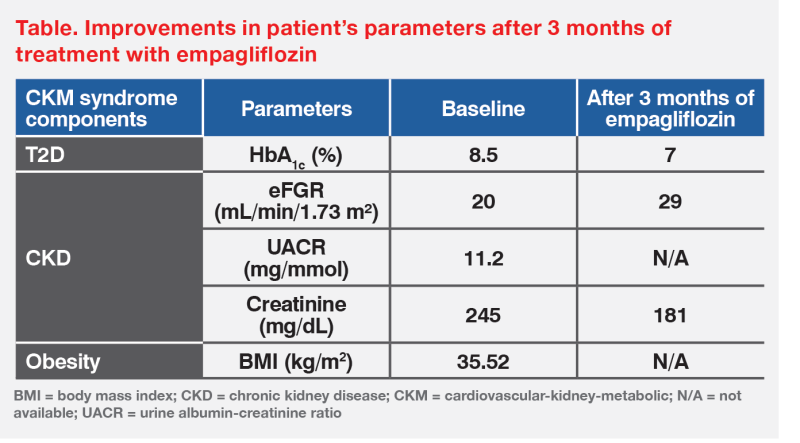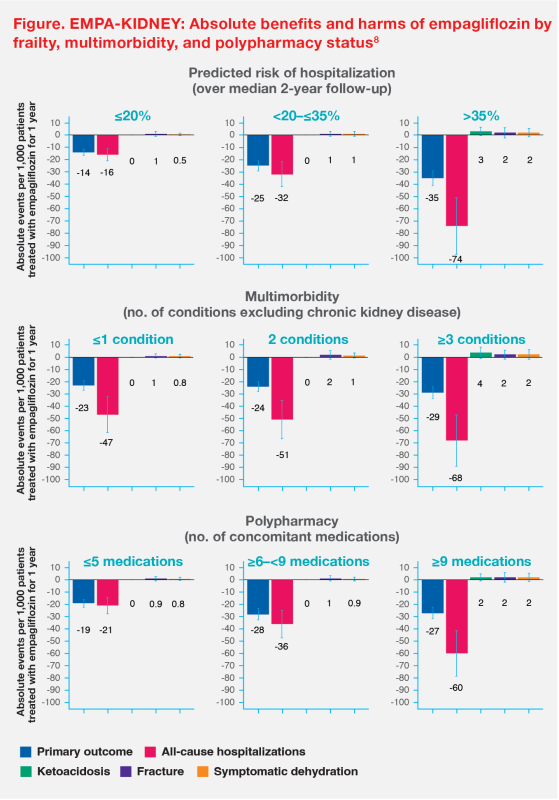Use of an SGLT2 inhibitor in an elderly patient with CKM syndrome and polypharmacy





History and presentation
An 82-year-old frail Chinese male patient with multimorbidity and polypharmacy was admitted to the rehabilitation ward in November 2024 due to prior ischaemic stroke and congestive heart failure (HF) requiring treatment with oxygen and furosemide. Focused cardiac ultrasound (FoCUS) showed a left ventricular ejection fraction (LVEF) of 50 percent, with formal echocardiography being scheduled for late 2025.
The patient had a history of gout, benign prostate hypertrophy, anaemia, lower back pain, sensorineural hearing loss, and cardiovascular-kidney-metabolic (CKM) syndrome. This included type 2 diabetes (T2D; diagnosed in 2011) with HbA1c of 8.5 percent, obesity with a body mass index (BMI) of 32.52 kg/m2, chronic kidney disease (CKD) with an estimated glomerular filtration rate (eGFR) of 20 mL/min/1.73 m2, a urine albumin-creatinine ratio (UACR) of 11.2 mg/mmol, and a serum creatinine level of 245 mg/dL, hypertension (117/75 mm Hg), and hyperlipidaemia (total cholesterol, 3.7 mmol/L; LDL-cholesterol, 1.62 mmol/L). (Table) Additionally, he was hospitalized 1 month earlier due to gastrointestinal bleeding and was scheduled to undergo colonoscopy in May 2025.

Treatment and response
The patient’s initial T2D medications included pioglitazone 30 mg QD, gliclazide 80 mg BID, linagliptin 5 mg QD, and twice-daily insulin. During rehabilitation, pioglitazone was switched to empagliflozin 10 mg QD because of his underlying HF and empagliflozin’s cardiorenal benefits, and insulin dosage was reduced to once daily. He was discharged with 16 different medications and was able to walk with minimal assistance.
The patient tolerated empagliflozin well without experiencing adverse events (AEs). In February 2025, after 3 months of treatment, his HbA1c decreased to 7 percent, eGFR increased to 29 mL/min/1.73 m2, and creatinine level decreased to 181 mg/dL. (Table) He remained well without developing new cardiovascular (CV) or kidney events.
Discussion
The Department of Health’s Report on the Population Health Survey (2020–2022) indicated that among individuals aged 15–84 years, 54.6 percent were obese or overweight, 51.9 percent had raised blood cholesterol or hypercholesterolaemia, and 8.5 percent had diabetes.1
CKM syndrome is defined by the American Heart Association (AHA) as a health disorder attributable to connections among obesity, diabetes, CKD, and CV disease (CVD), including HF, atrial fibrillation, coronary heart disease, stroke, and peripheral artery disease.2 Our patient, who was diagnosed with T2D 14 years ago, had developed progressive CKM syndrome over time, including obesity, hypertension, hypercholesterolaemia, CKD, and HF.
As the CV, renal, and metabolic systems are closely interconnected, CKM syndrome should be treated as a unified disease entity. In the 2025 American Diabetes Association (ADA) Guidelines, first-line treatment with sodium-glucose cotransporter 2 (SGLT2) inhibitors, such as empagliflozin, is given a class A recommendation for patients with T2D who have atherosclerotic CVD or high CVD risk, HF, or CKD. SGLT2 inhibitors can also be considered in T2D patients requiring weight management.3
The recommendations on empagliflozin are based on cardiorenal benefits in the EMPA-KIDNEY trial (in CKD patients with or without diabetes), the EMPA-REG OUTCOME trial (in T2D patients at high CV risk), and the EMPEROR-Reduced and EMPEROR-Preserved trials (in HF patients regardless of LVEF function and presence or absence of diabetes).4-7
Of note, EMPA-KIDNEY showed that empagliflozin significantly reduced the risk of progression of kidney disease or death from CV causes (primary outcome) in a diverse population of CKD patients, including those with a broad range of eGFRs (ie, from 20 to <90 mL/ min/1.73 m²) as well as in patients with normal to severely increased albuminuria (UACR, from <30 to >300 mg/g).4 In our patient, eGFR improved from 20 to 29 mL/min/1.73 m² after 3 months of treatment with empagliflozin.
Frailty, multimorbidity, and polypharmacy overlap and are associated with higher risk of adverse health outcomes in CKD. In a post-hoc analysis of EMPA-KIDNEY, multimorbidity (≥1 condition excluding CKD) and polypharmacy (≥5 concomitant medications) were present in 71 and 76 percent of patients, respectively. Of note, empagliflozin was safe, well tolerated, and effectively lowered the risk of progression of kidney disease or CV death and all-cause hospitalization, irrespective of baseline frailty (defined by predicted risk of hospitalization; pheterogeneity=0.60), multimorbidity (pheterogeneity=0.38), and polypharmacy (pheterogeneity=0.16). Additionally, absolute benefits exceeded any potential harm across the spectrums of frailty, multimorbidity, and polypharmacy.8 (Figure)

Consistently, our patient with polypharmacy and multimorbidity tolerated empagliflozin well without reporting any AEs. While patients in the rehabilitation ward are generally stable, they often remain in bed with reduced mobility. Patient education on hydration and sick-day rules are important to reduce risks of urinary tract infections and diabetic ketoacidosis, respectively.9 For example, SGLT2 inhibitors should be temporarily withheld when this patient undergoes colonoscopy in May 2025. As patients treated with empagliflozin may experience an initial dip in eGFR, regular monitoring of renal function is recommended following treatment initiation.10
In conclusion, physicians should practice evidence-based medicine when treating patients with CKM syndrome. Given the cardiorenal benefits and guideline recommendations, empagliflozin should be initiated as early as possible in patients with CKM syndrome. This includes patients with polypharmacy, multimorbidity, and frailty, as long as there is a valid indication for its use and no contraindications.